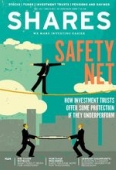Archived article
Please note that tax, investment, pension and ISA rules can change and the information and any views contained in this article may now be inaccurate.
Is broking research any use or not?

At just under 3,900, the FTSE 350 index stands about 10% below its mark of a year ago, which may depress some investors, especially those less experienced ones who did not experience the bear markets, of 2000 to 2003 and 2007 to 2009 or – going further back the Asian crisis of 1997-98 or the Black Monday crash of 1987.
But it has still been possible to make healthy gains. Five stocks – Ocado (OCDO), Hikma (HIK), Pearson (PSON), QinetiQ (QQ.) and EI Group (EIG) – are all up by 40% or more over the past 12 months and another 18 FTSE 350 firms’ shares advanced by 20% to 40%.
Unfortunately it has been easy to lose money as well. Ninety-two FTSE 350 stocks fell by 20% or more, including 15% shed more than 40% of their value. The four worst performers – British American Tobacco (BATS), Intu (INTU), Indivior (INDV) and Superdry (SDRY) – all more than halved.
This begs the question of how investors can find winners – or at least avoid portfolio-damaging losers.
PICK AND CHOOSE
One possible way is to at least narrow down an index as big as the FTSE 350 could be identify which firms are more and least preferred in the research written by analysts at the leading investment banks and broking firms. Granted, this is primarily intended for institutional investors but websites such as www.uk.webfg.com and the Broker Forecasts section of Shares’ own website provide a summary of how many analysts cover a stock and how many rate the stock a ‘buy’ or a ‘sell’ (or are sat on the fence with a ‘hold’).
However, a back-test of the data on the most and least popular stocks at the start of 2018 suggests that this research needs to be treated with kid gloves, especially when it comes to the FTSE 350.
As if to reinforce US investor Jim Rogers’ view that ‘The more certain something is, the less likely it is to be profitable’, the ten FTSE 350 firms which last January attracted the highest percentage of ‘buy’ ratings among the analysts only just beat the 13% capital loss generated by the FTSE 350 in calendar 2018. Just three of the ten rose in value.
In defence of the analysts at least the stocks that they most actively disliked did worse than the FTSE 350, with an aggregate 18.8% loss of value. Only two of those 10 stocks rose and one – Fidessa – was the subject of a bid, to confound bears of stocks.
WEALTH WARNING
The following conclusions can be drawn from this data:
– Seeking safety with the crowd by selecting the most-widely tipped FTSE 350 stocks did not work as a strategy. Instead it damaged investors’ wealth.
While it is tempting to cut analysts some slack by noting that 2018 was a tough year, this the fourth year in which AJ Bell has conducted this survey - and the analysts’ combined top picks fared no better than the benchmark index in 2015, 2016 or 2017.
– The analysts did a better job in avoiding trouble as the stocks with the highest percentage of ‘sell’ ratings lived down to their billing and did badly.
The temptation to simply blindly do the opposite to the consensus should therefore be resisted, not least as the past is no guide to the future and because if making money in the markets was that simple then every one would already be doing it.
Anyone prepared to pick their own stocks rather than pay a fund manager or index-tracker fund to do it for them must therefore thoroughly research any company for themselves before they even think about buying it shares.
If this sounds difficult, well, it is but at least investors can follow the lead of successful American investor Charlie Munger – Warren Buffett’s vice-chairman at Berkshire Hathaway – who boils it down to four things:
One, do you understand the business?
Two, does the business have intrinsic value
or durable competitive value?
Three, does management have integrity?
Four, does the stock come at a reasonable valuation?
Equally, if an investor likes what they see, they should not be put off just because they are out of step with consensus – they may have unearthed a nugget of value, assuming the stock passes the first three of Munger’s tests. Then they may be heeding Warren Buffett’s maxim that 'you can't buy what is popular and do well.'
THE YEAR AHEAD
With this year in mind, investors might like to know which stocks are most liked – and disliked – by analysts. The two tables below list the names which investors may wish to research – or avoid like the plague – depending upon their view of the value of the research provided.
Important information:
These articles are provided by Shares magazine which is published by AJ Bell Media, a part of AJ Bell. Shares is not written by AJ Bell.
Shares is provided for your general information and use and is not a personal recommendation to invest. It is not intended to be relied upon by you in making or not making any investment decisions. The investments referred to in these articles will not be suitable for all investors. If in doubt please seek appropriate independent financial advice.
Investors acting on the information in these articles do so at their own risk and AJ Bell Media and its staff do not accept liability for losses suffered by investors as a result of their investment decisions.

 magazine
magazine











